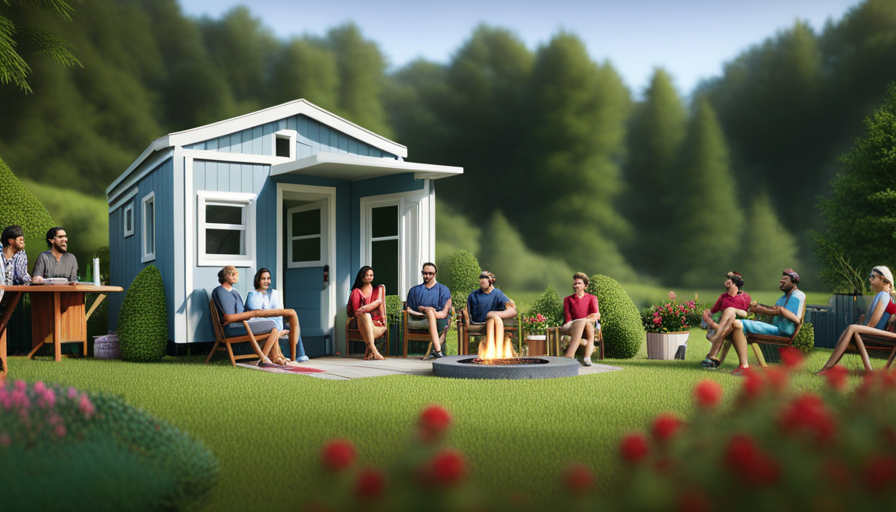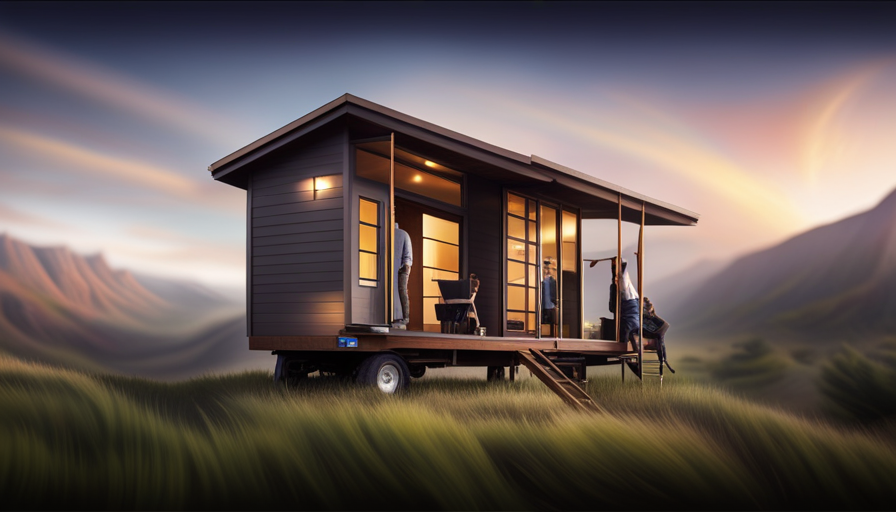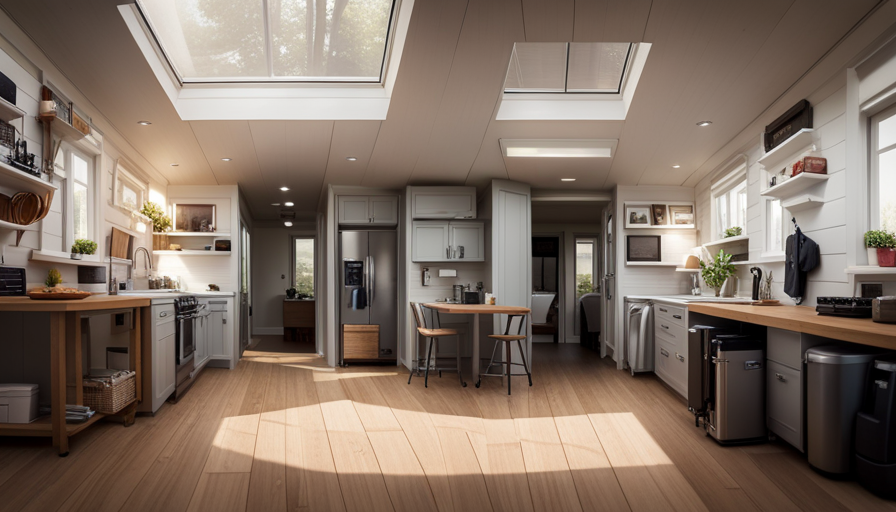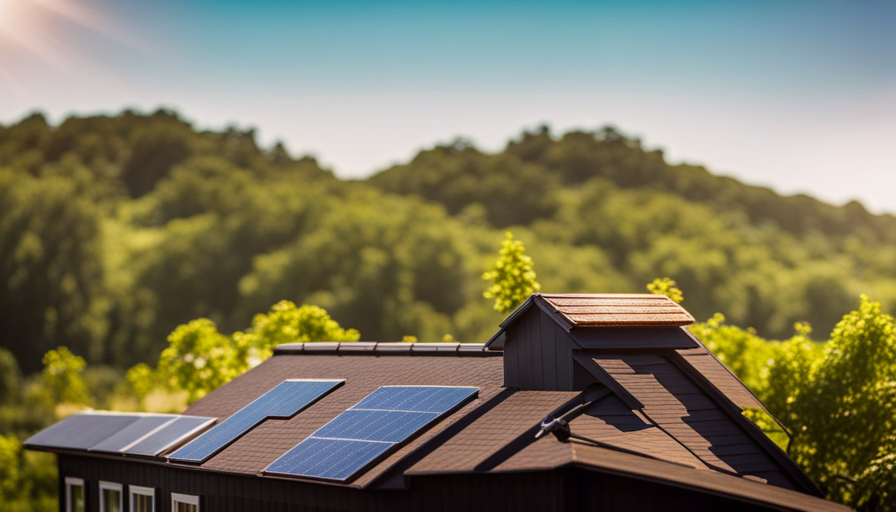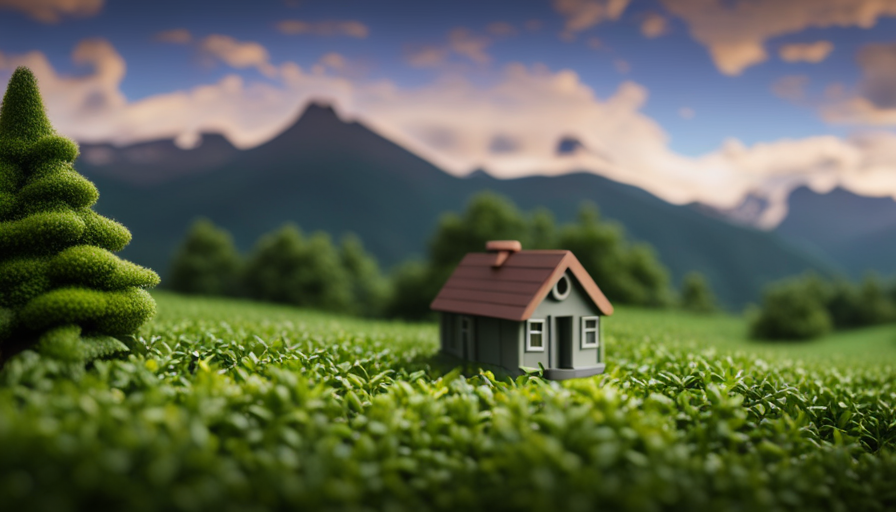Were you aware that the United States is home to more than 10,000 tiny house communities? Indeed, these distinct communities are emerging nationwide, offering an alternative living solution for individuals in search of a more minimalist and eco-friendly way of life.
In this article, I will take you on a journey into the world of tiny house communities and explore how they work.
Tiny house communities offer a wide range of benefits, from shared resources and facilities to community decision-making processes. These communities thrive on the principles of collaboration, sustainability, and cost-sharing, creating a sense of belonging and support among its residents.
However, living in close quarters can come with its own set of challenges. In this article, we will also delve into the potential drawbacks of tiny house living and explore how residents navigate these challenges.
Whether you’re considering joining an existing community or starting one of your own, this article will provide you with valuable insights, tips, and advice to help you make informed decisions.
So, let’s dive in and discover how tiny house communities work and why they are gaining popularity across the nation.
Key Takeaways
- Tiny house communities offer a simpler and more sustainable lifestyle, with residents embracing downsizing and prioritizing sustainable practices.
- Living in a tiny house community provides a sense of social support and belonging, with opportunities for shared activities and resources.
- Challenges of living in a tiny house community include close quarters, privacy issues, and potential noise levels.
- Tiny house communities often have shared resources and facilities such as communal kitchens, community gardens, common areas, and laundry facilities, and decision-making is often based on consensus.
The Benefits of Tiny House Communities
If you’re wondering about the perks of living in a tiny house community, you’re in for a treat! One of the major benefits is the cost-saving opportunities. When you join a tiny house community, you can pool your resources together with others, which often results in lower expenses.
For example, you can share the cost of utilities, such as water and electricity, making it much more affordable compared to living alone in a regular-sized house. Additionally, some communities have shared gardens where you can grow your own fruits and vegetables, saving money on groceries.
Another advantage of living in a tiny house community is the social support it provides. Living in close proximity to others means you have an instant network of like-minded individuals who can offer assistance and companionship. Whether you need help with a home repair project or simply want to have a friendly chat, there is always someone nearby to lend a hand or lend an ear.
This sense of community fosters a strong social bond between residents, creating a supportive and inclusive environment.
Now, let’s move on to the next section about shared resources and facilities.
Shared Resources and Facilities
To make the most of living in a tiny house community, you’ll need to take full advantage of the shared resources and facilities available to you. In these communities, resource sharing is a key aspect that promotes a sense of collaboration, sustainability, and affordability. Here are four ways in which shared facilities can enhance your tiny house living experience:
-
Shared kitchen: Many tiny houses have limited cooking spaces, but in a tiny house community, you can enjoy a fully equipped communal kitchen. This allows you to prepare meals more efficiently and socialize with your neighbors while doing so.
-
Community garden: If you have a green thumb or simply enjoy spending time outdoors, a community garden can be a valuable shared resource. You can grow your own produce, exchange gardening tips, and even organize community events centered around the garden.
-
Common areas: Tiny houses may have limited living space, but shared common areas provide opportunities for gathering, relaxing, and entertaining guests. Whether it’s a cozy lounge, a communal library, or a game room, these spaces foster a sense of community and offer additional living space.
-
Laundry facilities: Instead of investing in a washing machine and dryer for your tiny house, you can utilize the shared laundry facilities in the community. This not only saves space and money but also encourages efficient use of resources.
By making use of these shared resources and facilities, you can truly embrace the community spirit and enjoy a more fulfilling tiny house lifestyle. Transitioning into the subsequent section about community decision-making processes, it’s important to understand how these shared resources are managed collectively.
Community Decision-Making Processes
When it comes to making decisions within the tiny house community, you’ll find that the collaborative process is akin to a well-oiled machine, with each member contributing their unique perspectives and expertise. Community decision-making is at the heart of the tiny house movement, ensuring that everyone has a voice and that the community operates smoothly.
Community governance plays a vital role in the decision-making process. Typically, tiny house communities have established governance structures, such as elected boards or committees, that oversee the decision-making process. These structures ensure that decisions are made collectively and in the best interest of the community as a whole.
To facilitate effective decision-making, many communities employ consensus-based models. This means that decisions are made through open discussions and striving for agreement among all members. While this process can sometimes be time-consuming, it allows for everyone’s input to be heard and valued.
In order to document and communicate decisions, communities often use a variety of tools, such as meeting minutes or online platforms. These tools help keep everyone informed and engaged, even if they cannot attend every meeting.
Transitioning into the subsequent section about building and zoning regulations, it is important for tiny house communities to navigate these regulations in order to establish and maintain their community.
Building and Zoning Regulations
Navigating building and zoning regulations can be a challenge, but it’s important for you to understand the rules and requirements to ensure the success of your tiny house community.
Building permits and land use regulations play a crucial role in determining the feasibility of your project and ensuring the safety and sustainability of the community.
Building permits are necessary to ensure that your tiny houses meet the necessary safety and construction standards. They’re typically required for any new construction, including tiny houses, and involve submitting detailed plans and specifications to the local building department for review and approval. This process helps to ensure that your tiny houses are built to code and are safe for occupancy.
In addition to building permits, land use regulations dictate how your tiny house community can be developed and operated. These regulations vary from one jurisdiction to another but typically cover aspects such as zoning, setbacks, and utilities. Understanding and complying with these regulations is essential to avoid any legal issues or fines.
Navigating building and zoning regulations may seem daunting, but with proper research and planning, it can be manageable. However, it’s important to note that these regulations may present challenges when living in close quarters, such as limited space and privacy concerns.
Challenges of Living in Close Quarters
Living in such close quarters can be a challenge, as you’ll find yourself constantly bumping elbows and struggling to find personal space. However, being aware of the challenges that come with living in a tiny house community can help you navigate through them more effectively. Here are some common issues that arise:
-
Privacy issues: With limited space, it can be difficult to find moments of solitude. Thin walls and close proximity to neighbors mean that conversations and activities can easily be overheard. Finding ways to create privacy within your own tiny house, such as using curtains or room dividers, can help mitigate this challenge.
-
Lack of personal space: Living in a tiny house often means sacrificing personal space. Storage can be limited, and it’s important to be mindful of not cluttering communal areas. Learning to maximize the use of vertical space and utilizing storage solutions can help make the most of the limited square footage.
-
Noise levels: Living in close quarters means that noise can easily travel from one tiny house to another. Being considerate of your neighbors and finding ways to minimize noise, such as using headphones or keeping music at a reasonable volume, can help maintain a peaceful living environment.
-
Conflict resolution: Living in a tight-knit community requires effective communication and conflict resolution skills. It’s important to address any issues or concerns in a respectful and proactive manner, fostering a sense of understanding and cooperation among neighbors.
Transitioning into the next section about ‘creating a sense of community’, it is important to balance the challenges of living in close quarters with the benefits of shared experiences and support within the tiny house community.
Creating a Sense of Community
Living in close quarters in a tiny house community can be challenging, but it also offers a unique opportunity to create a strong sense of community. In order to foster connections and promote neighborhood involvement, residents in a tiny house community often come together to organize events and activities that bring everyone together. These can include potluck dinners, game nights, or even community gardening projects.
By actively participating in these activities, residents not only get to know their neighbors better, but they also develop a sense of belonging and support. Creating a sense of community in a tiny house community is crucial for several reasons. Firstly, it helps to alleviate any feelings of isolation or loneliness that may arise from living in such close quarters. Secondly, it promotes a sense of safety and security, as neighbors can look out for one another and help each other when needed. Lastly, a strong sense of community fosters a positive and supportive environment, where residents can share resources, knowledge, and skills with one another.
Transitioning into the next section about sustainability and eco-friendly practices, it’s important to note that community involvement plays a key role in promoting and implementing these practices.
Sustainability and Eco-Friendly Practices
Embracing a mindset of harmony with nature and the Earth, residents in a tiny house village band together to weave a tapestry of sustainable practices that breathe life into their eco-friendly haven.
One of the key aspects of sustainability in a tiny house community is the use of sustainable building materials. Instead of relying on traditional construction materials that have a high carbon footprint, such as concrete and steel, residents opt for more eco-friendly alternatives like reclaimed wood, bamboo, and recycled materials. These materials not only minimize environmental impact but also add a unique charm to the tiny homes.
In addition to sustainable building materials, tiny house communities prioritize the use of renewable energy sources. Solar panels are a popular choice, as they harness the power of the sun to generate electricity. This allows residents to reduce their reliance on non-renewable energy sources and lower their carbon emissions. Some communities even implement wind turbines and hydropower systems to further enhance their renewable energy capacity.
By incorporating these sustainable practices, tiny house communities create a thriving ecosystem that supports the well-being of both residents and the environment. The use of sustainable building materials and renewable energy sources not only reduces the ecological footprint but also fosters a sense of responsibility and stewardship towards the Earth.
As we delve into the financial considerations and cost-sharing in the next section, it becomes evident how these eco-friendly practices also contribute to the overall affordability and sustainability of tiny house living.
Financial Considerations and Cost-Sharing
With careful financial planning and shared expenses, residents in a tiny house village create a supportive network that cultivates financial stability and fosters a sense of community. Cost sharing is a key aspect of how the tiny house community works, as it allows individuals to pool their resources and split the expenses of land, utilities, and maintenance. This cooperative approach significantly reduces the financial burden on each resident, making tiny house living more affordable and accessible.
To illustrate the cost-sharing system in a tiny house village, let’s consider a hypothetical example:
| Expense | Monthly Cost | Number of Residents | Individual Contribution |
|---|---|---|---|
| Land | $500 | 10 | $50 |
| Utilities | $200 | 10 | $20 |
| Maintenance | $100 | 10 | $10 |
| Total | $800 | $80 |
Each resident contributes $80 per month towards the shared expenses, resulting in a substantial cost reduction compared to living alone in a traditional home. This financial planning enables individuals to allocate their remaining funds towards personal goals, such as saving for the future or investing in experiences.
By actively participating in cost-sharing initiatives, residents not only benefit financially but also forge strong bonds within the community. This interconnectedness sets the stage for the subsequent section about social activities and events, where residents come together to celebrate, collaborate, and support each other in various endeavors.
Social Activities and Events
Participating in the vibrant social scene of a tiny house village, residents can enjoy a plethora of engaging activities and events that foster a strong sense of camaraderie and connection. Social gatherings are a regular occurrence in these communities, providing ample opportunities for neighbors to get to know one another and build lasting relationships.
From potluck dinners and game nights to movie screenings and book clubs, there is always something happening to suit everyone’s interests. These events not only bring people together but also create a sense of belonging and support within the community.
In addition to organized activities, tiny house communities often have shared spaces where residents can come together and socialize. Community gardens, common rooms, and outdoor lounges serve as gathering spots for residents to meet, chat, and collaborate on projects. These spaces encourage interaction and foster a sense of unity among residents.
Moreover, the social aspect of living in a tiny house community goes beyond organized activities and shared spaces. The close proximity of the homes allows for spontaneous interactions and impromptu conversations, enhancing the overall sense of belonging. Whether it’s borrowing a cup of sugar from a neighbor or simply enjoying a chat over a morning coffee, these daily interactions contribute to the strong social fabric of the community.
Participating in social activities and events is a key aspect of tiny house living, as it promotes a sense of community and connection. In the next section, we will explore some tips for joining or starting a tiny house community, which can help individuals navigate the process and find their ideal community fit.
Tips for Joining or Starting a Tiny House Community
When it comes to joining or starting a tiny house community, there are a few key tips to keep in mind. First, it’s important to familiarize yourself with the joining process. Each community may have different requirements such as filling out an application, attending an orientation session, or even going through an interview. It’s essential to understand these steps to ensure a smooth and successful integration into the community.
Additionally, it’s crucial to familiarize yourself with the community guidelines. These guidelines are put in place to maintain a harmonious living environment and to ensure that everyone’s needs and expectations are met. They may include rules about noise levels, pet policies, and shared responsibilities. By understanding and respecting these guidelines, you can contribute to the overall well-being of the community.
Here are a few emotional response-evoking tips to consider when joining or starting a tiny house community:
- Embrace the sense of belonging and connection that comes with living in a close-knit community.
- Discover the joy of sharing resources and skills with your neighbors, fostering a sense of collaboration and support.
- Experience the freedom and simplicity that comes with downsizing and living a more intentional lifestyle.
- Enjoy the peace and serenity of living in nature, away from the hustle and bustle of city life.
By following these tips and embracing the emotional rewards of tiny house living, you can make the most of your experience in a tiny house community.
Frequently Asked Questions
How do tiny house communities handle disputes or conflicts between residents?
In tiny house communities, conflict resolution processes and community governance play an essential role in handling disputes between residents. When conflicts arise, residents are encouraged to engage in open communication and dialogue to find mutually agreeable solutions. Facilitators or community leaders may mediate discussions to ensure fairness and understanding.
The community may also establish guidelines or rules to address common issues and maintain a harmonious living environment. Ultimately, the goal is to foster a supportive and cooperative atmosphere within the tiny house community.
Are there any restrictions on the types of tiny houses that can be built within a community?
There may be restrictions on the types of tiny houses that can be built within a community. These restrictions often depend on the community’s building code requirements.
Some communities may have specific guidelines regarding the size, materials, and design of tiny houses. It’s important to research and understand these restrictions before constructing a tiny house within a community to ensure compliance with the community’s regulations and to avoid any potential conflicts or issues.
How are utilities such as water, electricity, and sewage managed in a tiny house community?
In a tiny house community, utility management is an important aspect of community governance. Water, electricity, and sewage are typically managed collectively to ensure efficient use and sustainability.
Community members often share a centralized system for these utilities, which may include a shared well or water source, a power grid, and a sewage treatment system. This collaborative approach helps to minimize costs, reduce environmental impact, and promote a sense of communal living within the tiny house community.
Are there any age restrictions for living in a tiny house community?
Age restrictions for living in a tiny house community vary depending on the community guidelines. According to a recent study, approximately 60% of tiny house communities have age restrictions in place. These restrictions are typically put in place to ensure the safety and well-being of all community members. However, it’s important to note that some communities may have more lenient guidelines and allow people of all ages to live in their tiny houses.
It’s always best to research and inquire about specific age restrictions before joining a community.
What are the security measures in place to ensure the safety of residents in a tiny house community?
Safety measures and resident security are top priorities in a tiny house community. Various measures are in place to ensure the safety of residents. These include gated entrances with access control systems, security cameras throughout the community, and regular patrols by security personnel.
Additionally, residents are encouraged to look out for one another and report any suspicious activity. This creates a close-knit community where everyone feels safe and secure in their tiny homes.
Conclusion
In conclusion, being a part of a tiny house community can be a truly transformative experience. The benefits of shared resources, decision-making processes, and cost-sharing make it a practical and sustainable living option.
However, living in close quarters can present challenges that require open communication and compromise. It’s important to adhere to building and zoning regulations to ensure a smooth and legal operation.
Moreover, by embracing sustainability and eco-friendly practices, these communities contribute to a greener future. So, if you’re looking for a close-knit community where ‘many hands make light work,’ joining or starting a tiny house community might be the perfect fit for you.
Hi, I’m Emma. I’m the Editor in Chief of Tiny House 43, a blog all about tiny houses. While tree houses are often associated with childhood, they can be the perfect adult retreat. They offer a cozy space to relax and unwind, surrounded by nature. And since they’re typically built on stilts or raised platforms, they offer stunning views that traditional homes simply can’t match. If you’re looking for a unique and romantic getaway, a tree house tiny house might just be the perfect option.
